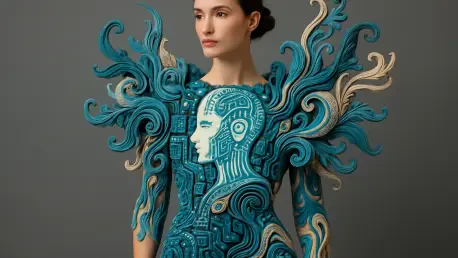In an era where technology intertwines with every facet of life, artificial intelligence (AI) is emerging as a transformative force in the fashion industry, turning garments and accessories into breathtaking pieces of wearable art. This isn’t merely about adopting the latest trends or accelerating production timelines; it represents a profound shift where digital innovation collaborates with human creativity to redefine the very essence of style. From crafting visually stunning designs that defy convention to championing eco-conscious practices, AI is breaking new ground in an industry long celebrated for its flair and originality. This remarkable synergy between machine intelligence and artistic vision is paving the way for a future where fashion transcends utility, becoming a canvas for personal expression and cultural storytelling. As this technological wave sweeps through ateliers and design studios, it sparks curiosity about how such advancements can reshape not only what people wear but how they perceive beauty and innovation in everyday life.
AI as a Creative Collaborator
Artificial Intelligence has moved far beyond its initial role as a background tool for data analysis, stepping boldly into the realm of creative partnership within the fashion world. By processing enormous datasets encompassing historical fashion archives, current cultural movements, and advanced material properties, AI empowers designers to generate intricate patterns and anticipate emerging runway trends with uncanny precision. This collaboration accelerates the ideation phase, enabling artists to explore concepts that might have previously seemed out of reach due to time or resource constraints. The technology acts as a digital muse, suggesting combinations of textures and forms that challenge traditional design norms, thus expanding the creative horizon. Such a partnership doesn’t just streamline workflows; it fosters an environment where experimentation thrives, allowing for the birth of collections that captivate and inspire audiences globally with their originality and depth.
Moreover, this alliance between human ingenuity and machine learning introduces a new dynamic to the design process, where AI serves as a sounding board for innovative ideas. Designers can input initial sketches or concepts into AI systems, which then offer variations or enhancements based on vast trend analyses and aesthetic principles. This iterative process not only refines the final output but also sparks inspiration by presenting options that might not have been considered otherwise. The speed and scalability of AI-driven tools mean that collections can be developed with greater efficiency, freeing up time for creators to focus on storytelling and emotional resonance in their work. As a result, the fashion industry witnesses a surge in bold, boundary-pushing designs that redefine what clothing can represent, blending art with technology in ways that captivate modern sensibilities and set the stage for future sartorial revolutions.
Transforming Fashion into Wearable Art
One of the most captivating impacts of AI in fashion lies in its ability to elevate clothing and accessories into genuine works of wearable art. Leveraging cutting-edge technologies like Generative Adversarial Networks (GANs), designers can produce unique prints and structural forms that seamlessly merge historical influences with avant-garde, futuristic aesthetics. These creations go beyond mere functionality, serving as profound expressions of individuality and cultural commentary that challenge conventional perceptions of style in the 21st century. The intricate patterns and unexpected silhouettes born from AI algorithms captivate the eye, turning everyday wear into gallery-worthy pieces that spark conversation and admiration. This transformation underscores a shift in the industry, where the boundaries between fashion and fine art blur, inviting consumers to engage with clothing as a medium of personal and societal reflection.
Additionally, AI’s role in crafting wearable art extends to redefining how inspiration is sourced and applied in design. By analyzing diverse global aesthetics and cross-referencing them with contemporary tastes, AI tools enable the creation of pieces that resonate on a deeply emotional level while pushing visual boundaries. This technology allows for the fusion of disparate elements—think ancient motifs paired with cyberpunk vibes—resulting in collections that feel both timeless and ahead of their time. Such innovation not only captivates fashion enthusiasts but also reimagines the runway as a space for artistic exploration rather than just commercial display. As AI continues to refine its generative capabilities, the potential for truly bespoke, artful designs grows, promising a future where every garment tells a unique story, crafted with the precision of technology and the passion of human creativity.
Driving Sustainability through Technology
AI is also playing a pivotal role in addressing one of the fashion industry’s most pressing challenges: sustainability. By evaluating the environmental impact of various materials and forecasting the durability of specific designs, AI tools assist brands in making informed choices that prioritize eco-friendliness without sacrificing style. Companies like Stella McCartney and Adidas have harnessed these capabilities to produce collections that balance stunning aesthetics with a commitment to reducing carbon footprints. This technological intervention aligns perfectly with the growing consumer demand for responsible fashion, proving that beauty and environmental stewardship can coexist. Through precise data analysis, AI helps minimize waste during production and encourages the use of sustainable fabrics, setting a new standard for how the industry can operate in harmony with planetary needs.
Furthermore, the integration of AI in sustainable fashion extends to optimizing supply chains and reducing overproduction, a significant contributor to environmental degradation. Advanced algorithms can predict consumer demand with remarkable accuracy, ensuring that brands produce only what is needed, thus cutting down on excess inventory that often ends up in landfills. This predictive power also aids in selecting materials with lower ecological impacts, guiding designers toward innovations like biodegradable textiles or recycled fibers. The result is a more circular approach to fashion, where longevity and environmental consciousness are embedded into the creative process. As AI-driven insights become more accessible, even smaller brands can adopt these practices, amplifying the industry’s shift toward a greener future and reinforcing the idea that technology can be a powerful ally in the fight against climate change.
Democratizing Design and Inclusivity
The advent of AI in fashion is tearing down long-standing barriers, making the tools of design accessible to a broader range of creators beyond just elite fashion houses. Platforms like Cala and Fashwell provide independent designers with affordable means to prototype and visualize their concepts, leveling the playing field in an industry often dominated by big players. This democratization empowers emerging talents, particularly from underrepresented communities, to bring their unique visions of wearable art to life without the burden of exorbitant costs. As a result, the fashion landscape becomes richer and more diverse, reflecting a wider array of cultural narratives and personal stories through innovative designs. Such inclusivity not only fosters creativity but also ensures that the industry evolves to mirror the varied identities of its global audience.
Beyond accessibility, AI enhances inclusivity by enabling customization that caters to diverse body types and aesthetic preferences, often overlooked by traditional fashion norms. Algorithms can analyze consumer feedback and physical data to suggest designs that fit a wider spectrum of individuals, ensuring that style is not a privilege but a universal right. This shift challenges outdated standards, promoting collections that celebrate individuality rather than conforming to a narrow ideal. Additionally, by amplifying voices from marginalized groups through accessible technology, AI helps dismantle systemic biases within the industry, encouraging a marketplace where innovation thrives on diversity. The ripple effect of this transformation is profound, as it redefines fashion as a space for all, where every creator has the chance to contribute to the evolving tapestry of wearable art with tools that were once out of reach.
Addressing Ethical Challenges
While AI’s integration into fashion heralds incredible advancements, it also brings forth significant ethical considerations that demand careful scrutiny. A central concern revolves around authorship—when a design is generated by AI, who claims ownership: the human designer or the machine? This ambiguity raises questions about intellectual property in an era where technology plays such a pivotal role in creation. Additionally, there’s the risk that AI datasets, if not curated with diversity in mind, might reinforce narrow beauty standards, sidelining cultural expressions that don’t align with dominant norms. These challenges highlight the need for robust guidelines to ensure that AI serves as a tool for fairness rather than perpetuation of inequity. Addressing these issues is crucial to maintaining the integrity of fashion as a space for authentic human expression.
Moreover, the reliance on AI in design sparks debate about the potential erosion of traditional craftsmanship, a cornerstone of many cultural heritages. As machines take on more creative tasks, there’s a fear that the skills passed down through generations could be undervalued or lost. Balancing technological innovation with the preservation of artisanal techniques requires a thoughtful approach, ensuring that AI complements rather than competes with human hands. Another layer of complexity lies in the transparency of AI processes—consumers and creators alike deserve clarity on how designs are influenced by algorithms to maintain trust in the creative process. Tackling these ethical dilemmas head-on will shape how AI is perceived in fashion, determining whether it becomes a unifying force for progress or a source of contention in an industry already grappling with issues of equity and authenticity.
Envisioning Tomorrow’s Wearable Tech
Looking toward the horizon, AI’s influence on fashion is poised to venture into groundbreaking territory with the development of wearable technology that redefines personal expression. Imagine jewelry that shifts its design in response to emotional states or textiles embedded with sensors to monitor vital health metrics in real time. Such innovations promise a future where fashion becomes an intimate extension of the wearer, blurring the lines between creator, technology, and individual. This hyper-personalized approach could transform how people interact with their wardrobes, making style a dynamic reflection of both physical and emotional well-being. As AI continues to evolve, these advancements hint at a world where clothing is not just seen but felt and experienced in profoundly personal ways, pushing the boundaries of wearable art to new frontiers.
Additionally, the potential of AI-driven wearable tech extends into enhancing functionality while maintaining aesthetic appeal, creating pieces that are as practical as they are beautiful. Smart fabrics could adapt to environmental conditions, offering warmth or cooling as needed, while still showcasing stunning designs generated through AI algorithms. This fusion of utility and artistry caters to a modern audience that values both innovation and style, reimagining fashion as a multi-dimensional experience. The implications for health and wellness are equally exciting, as garments could alert wearers to medical concerns or stress levels, integrating seamlessly into daily life. As research and development in this space accelerate over the coming years, the collaboration between AI and fashion will likely yield creations that not only captivate the eye but also enrich lives, setting a transformative precedent for how technology can enhance human connection through style.
Reflecting on a Tech-Driven Legacy
Reflecting on the journey so far, AI has carved a remarkable path in the fashion industry, turning the concept of wearable art into a tangible reality through innovative collaborations and sustainable initiatives. It has reshaped the creative process by offering tools that amplify human imagination, foster inclusivity among diverse designers, and address pressing environmental concerns with data-driven precision. Ethical debates around authorship and cultural representation have prompted critical discussions, ensuring that technology’s role remains under scrutiny for fairness. Looking ahead, the next steps involve refining these tools to prioritize transparency and diversity in datasets, while investing in education to blend traditional craftsmanship with digital advancements. Encouraging global dialogue on wearable tech’s potential will further solidify AI’s place as a partner in crafting a future where fashion not only reflects beauty but also embodies responsibility and individuality.









